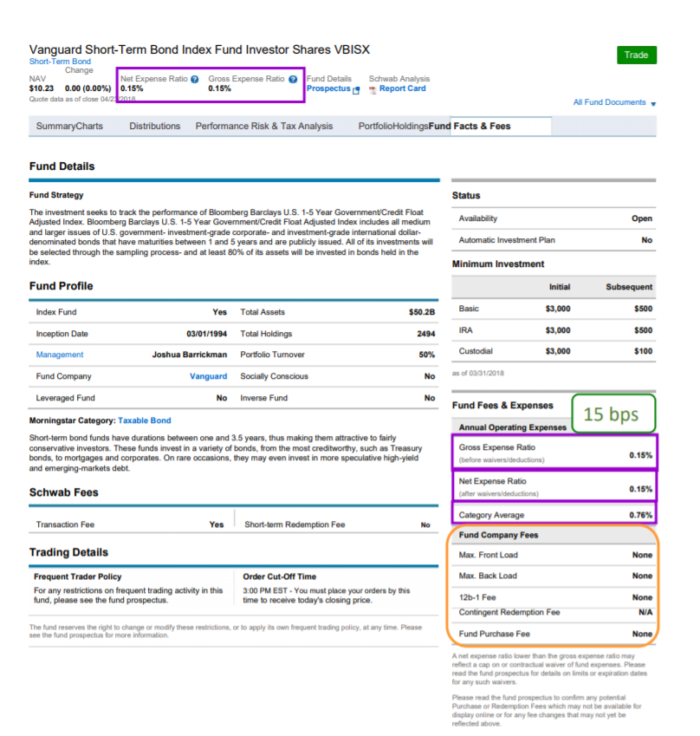Find Those Fees

Changes are afoot in the fee world. Transaction fees for buying and selling stock are, for the most part, gone. Schwab , Fidelity , Vanguard and others have eliminated transaction fees to buy or sell stocks and some exchange traded funds.
I tested out the new “ no transaction fee” policy by placing a few trades. Yep, transaction fees are gone for individual stock trades. But the “no transaction fee” doesn’t help if you are invested in mutual funds.
Saving a few dollars on a stock transaction isn’t going to eliminate some of the largest fees you pay. The largest fees are expense ratios in mutual funds.
A recent article in the Wall Street Journal reminded me again how difficult it is to understand fees. The article is “Time for Advisors to Speak in Plain English” by Jason Zweig as part of his Intelligent Investor column. The article was published on October 18th of this year.
https://www.wsj.com/articles/time-for-advisers-to-speak-to-us-in-plain-english
I found the article interesting because Mr. Zweig talks about the lack of disclosure and ongoing conflicts of interest in fee land.
There are several different types of fees associated with mutual funds. The two I am going to focus on in this article are 12b-1 fees and the expense ratio.
The 12b-1 fee.
12b-1 fees were established to pay brokers and advisors who sell shares of a specific mutual fund. It is a commission. 12b-1 fees are also used to defray the costs of advertising and marketing of a mutual fund.
A friend asked me to look at a fund recently . The advisor recommended a mutual fund that has a 12b-1 fee. The fee is 0.25% ( translation: 25 basis points or a quarter of a percent). A 12b-1 fee is a direct payment to the broker/advisor.
Expense Ratio
The second fee is called an expense ratio. Mutual funds have expense ratios. Exchange traded funds have expense ratios. Expense ratios represent the costs of managing a fund. Costs include the management fee, administrative fees and regulatory expenses .
The expense ratio is different from a fee you pay an advisor.
The expense ratio can be found on any product page for a mutual fund or exchange traded fund. It can also be found in the prospectus.
Expense ratios are not going away. Never going away.
You might not pay a transaction fee to buy an exchange traded fund, but you will pay the expense ratio.
The fund my friend asked me to look up has an expense ratio of 1.16% AND a 12b-1 fee of 0.025%. In addition, the advisor is charging a 0.75% management fee . All in, the cost to buy the fund is 2.15%. That is just plain ridiculous. And an obvious conflict of interest.
Management fee : 0.75%
12B-1 fee: 0.25%
Expense ratio : 1.15%
The advisor is charging a management fee and is receiving a 12b-1 fee.
Taking a management fee and a 12B-1 fee is a conflict of interest because the advisor has an incentive to put you in a share class that he or she benefits from directly.
What the advisor should do is recommend similar funds without a 12B-1 fee.
The advisor also needs to show multiple funds with a range of expense ratios.
Remember you always have a choice when it comes to buying a mutual fund or an exchange traded fund.
What if you own mutual funds and exchange traded funds ?
What you need to do is identify any mutual funds or exchange traded funds you currently own.
The easiest way to look up shares of a fund is with the ticker symbol. A ticker symbol is a combination of 5 letters. So, it is not a “symbol” at all. Ticker symbols are always shown on a statement next to each of your investments.
Use the ticker symbol to look up the fund on your custodian’s platform. For example, if you have an account at Schwab ( the custodian), you can enter the ticker symbol to see the expense ratio.
Expense ratios are shown in percentages like this: 0.35%.
Translation: the expense ratio is 35 basis points or roughly one third of one percent .
The expense ratio is deducted from the share price. In mutual funds it is deducted over the course of the year, so you don’t see a big drop in the share price.
There is no standard amount for expense ratios. Expense ratios are determined by the manager of the mutual fund or exchange traded fund and you need to look it up to know how much it is.
I have attached an example of a mutual fund. The ticker symbol is VBISX.

The expense ratio is 0.15% ( translation: 15 basis points). There is no 12b-1 fee. There is a transaction fee .
If you are talking to a broker or advisor about a mutual fund, tell them the following:
- I want a fund without a 12b-1 fee
- I want a fund with a relatively low expense ratio. (low compared to other similar funds)
Over a year ago I wrote an article on Mutual Fund Fees. In the article are 2 videos to help you find fees.
Click on this link to read the article.
Click on the links below to watch the videos.
How to Find Mutual Fund Fees – Part 1
How to Find Mutual Fund Fees – Part 2
This isn’t the end of the fee story.
In my next article I am going to explain what share classes are. Different share classes have fees as well.
This website is for informational purposes only and does not constitute an offer to sell, a solicitation to buy, or a recommendation for any security, nor does it constitute an offer to provide investment advisory or other services by The Modest Economist LLC.
